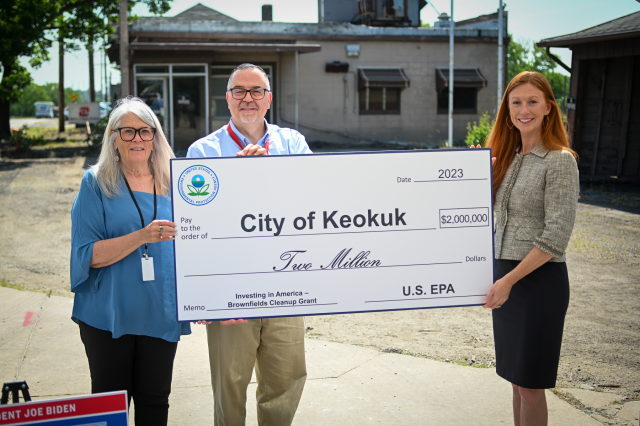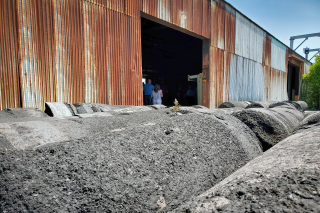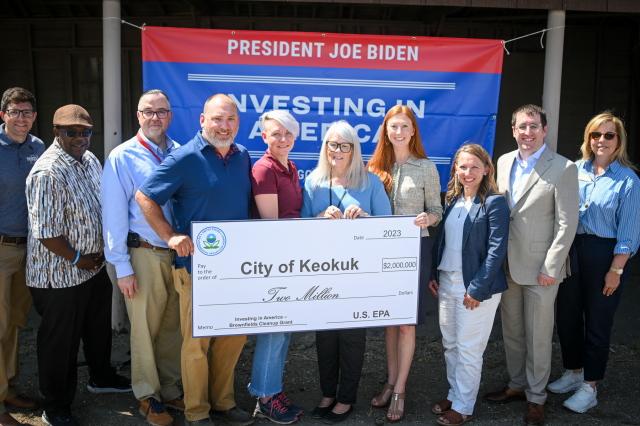Limitless Potential: Keokuk, Iowa, Aims to Revitalize Old Elkem-Carbide Site
– EPA Region 7 Feature –
By Madelyn Bremer, Office of Public Affairs
Small but Mighty on the Mississippi
Situated on bluffs between the Des Moines and Mississippi rivers in the southeastern corner of Iowa, the small town of Keokuk is the southernmost city in the state. With a population just over 9,900 and approximately 10 square miles in area, Keokuk ranks 36th on the list of Iowa's largest cities. Though what Keokuk lacks in size, the city makes up for in big opportunities.
On June 6, 2023, EPA Region 7 Administrator Meg McCollister presented a $2 million check funded by the Bipartisan Infrastructure Law to help Keokuk achieve its goal of revitalizing an abandoned carbide plant – no small feat for a small Midwestern town. However, this funding did not come from circumstance. Keokuk's $2 million grant was one of the largest grants offered in 2023 by EPA Region 7's Brownfields program and is a testament to years of redevelopment efforts and building local, state, and federal partnerships.
Keokuk’s Elkem-Carbide Brownfield Site
For over 100 years, Keokuk’s economy depended heavily on industrial manufacturing. In 2007, the Elkem-Carbide plant halted operations and the site quickly fell into disrepair after the factory's closure. The plant sat vacant for over 14 years, where it gave way to deteriorating conditions and vandalism.
The Elkem-Carbide site covers approximately 79 acres and consists of over a dozen buildings used for several industrial purposes since the plant opened in the 1920s, including zinc smelting, lead alloying, and carbon manufacturing.
The site now has several environmental concerns, including residual contamination from toxic materials, suspected waste dumping, landfilling, asbestos, and lead-based paint.
Although the city has made efforts to address the environmental concerns at the Elkem-Carbide site, redevelopment has not come without complications.
Keokuk has engaged in revitalization efforts with Iowa state officials for over a decade to evaluate the site. The Iowa Department of Natural Resources (IDNR) helped with initial site assessments and worked to determine the best course of action for redevelopment. However, state resources ran out and the IDNR Voluntary Cleanup program’s Mel Pence pointed the city of Keokuk to EPA Region 7’s Brownfields program.
Revitalized Brownfields Made Possible by the Bipartisan Infrastructure Law
EPA’s Brownfields program is designed to aid communities as they revitalize old and abandoned sites left empty due to environmental concerns. However, Brownfields is more than just a grant program.
“EPA provides resources and technical assistance to help safely clean up and return these sites to productive use,” says Stan Walker, EPA Region 7 Brownfields manager. “Thanks to $1.5 billion from the Bipartisan Infrastructure Law, EPA’s Brownfields program can now help more than ever before.”
Additional funding from the Bipartisan Infrastructure Law (BIL) allows the Brownfields program to assist more communities with their redevelopment efforts. With investments from BIL, EPA can fund more projects, offer greater rewards, and reach more communities, making program support more accessible to communities throughout Region 7's four states.
“Cities throughout the U.S. have Brownfield projects in need of redevelopment,” Walker says. “EPA is committed to helping these cities achieve their goals, but it’s up to the community to make that first step and reach out for assistance.”
Community stakeholders can contact EPA for help throughout any part of the revitalization process, even before they’re ready to clean up the site. In addition to cleanup grants, the Brownfields program offers grant options that provide funding for the redevelopment and assessment of brownfield sites at any stage in their journey. As of July 2023, Region 7’s Brownfields program has provided over $14 million in funding for the assessment, cleanup, and redevelopment of brownfield sites.
Redevelopment Through the Brownfields Program
The first contact between EPA and the city of Keokuk came in the form of a Targeted Brownfields Assessment (TBA). A TBA is a grant of services performed by independent contractors that a project can utilize after they have exhausted available state resources to assess potential brownfield sites. These contractors aid the community with feasibility studies to determine what is possible and viable for redevelopment; collaborate on ideas for revitalization; and offer technical resources to lead stakeholders in the right direction.
There are four TBA activities and a site can access just one resource or all of them if need be. Keokuk is currently undergoing all four assessments offered by a TBA in different areas of the site.
Contractors performed an initial site investigation in Keokuk that examined the Elkem-Carbide plant’s history, geology, and environmental background. After the initial assessment, a full site inspection identified environmental contaminants by sampling; these two phases of investigation were followed by a hazardous materials survey and an analysis of cleanup alternatives.
Keokuk’s Elkem-Carbide plant is so large that, even today, only parts of the compound have been assessed and documented. Contractors are still working on reports to identify all the contaminants on-site. As of July 2023, only an 8-acre parcel in the central part of the site has undergone all four TBA activities and is ready for cleanup. To move forward with remediation efforts, TBA contractors encouraged Keokuk to apply for a Brownfields Cleanup Grant.
The grant application was completed by Keokuk’s environmental consultant, municipal government, and Regional Planning Commission. It took several months of planning to complete the application, but the city's efforts proved worthwhile when Keokuk received a $2 million grant from EPA Region 7’s Brownfields program to assist in cleanup activities at the Elkem-Carbide site.
Community Impact of Site Revitalization
The Keokuk community has been very involved in the Brownfields process. According to Keokuk Mayor Kathie Mahoney, she was elated to hear that the city won the grant, as the municipal government has been deeply engaged in revitalization efforts.
“The grant from the EPA will let the community begin to rehabilitate the property, providing opportunities for growth,” Mahoney said. “A clean site will allow the city to eventually establish the property as a certified site for economic development. This certification will give Keokuk an edge over other sites when recruiting new business and industry.”
When the City Council approved the grant application and made it available for public comment, community organizations, property owners, developers, and other members of the public shared their comments and input on the grant application process. The public is happy to see the site remediated because it offers an opportunity for community development and will hopefully bring new jobs and production into Keokuk.
“This grant is just the first step in the cleanup process, and every successful endeavor needs a first step,” Mahoney said.
Future of the Elkem-Carbide Site
Although there are no definitive end-use redevelopment plans for the former Elkem-Carbide plant, the city hopes to redevelop the site for commercial use. The available infrastructure in the area surrounding the site makes the redeveloped plant a prime location for prospective businesses. With nearby access to the Mississippi River, four-lane highways, ample railway, and its designation as a former brownfield site, the community is hopeful that the revitalized plant will likely attract new industries to Keokuk.
The city anticipates the first slate of developers will move into the initial cleanup site in 2026, and the rest of the 79-acre property is expected to be completely revitalized by 2035, bringing new jobs and millions of dollars in revenue to the area.
Limitless Opportunities Provided by the Bipartisan Infrastructure Law
Keokuk was selected for the $2 million grant option, the highest award offered by the Brownfields program. Although the city competed against other large projects in major cities, Keokuk was chosen due to the site’s potential and great need. With funding from the Bipartisan Infrastructure Law, the opportunities for the future of the Elkem-Carbide site are limitless.
Although Keokuk is still in the beginning stages of its brownfield redevelopment process, the city serves as an example of how small communities can benefit from the EPA Brownfields program. Small towns like Keokuk should apply for Brownfields grants because they likely have brownfield sites in need of attention, and EPA is eager to partner with communities to help them achieve their goals, no matter where they are in the process.





